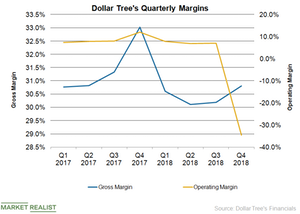Analyzing Dollar Tree’s Margins in 2018
Dollar Tree’s (DLTR) gross margin fell to 30.8% in the fourth quarter of fiscal 2018 from 33.0% in the fourth quarter of fiscal 2017.
March 8 2019, Updated 9:00 a.m. ET

Gross margin
Dollar Tree’s (DLTR) gross margin fell to 30.8% in the fourth quarter of fiscal 2018[1. Fiscal 2018 ended on February 2, 2019] from 33.0% in the fourth quarter of fiscal 2017. The Dollar Tree segment’s gross margin contracted by 90 basis points to 37.1% in the fourth quarter due to higher occupancy costs, an unfavorable comparison with the fourth quarter of fiscal 2017 (included an extra week), higher merchandise costs including freight, and higher shrink costs.
The Family Dollar segment’s gross margin fell to 23.6% in the fourth quarter from 27.6% in the fourth quarter of fiscal 2017. The significant decline reflected higher markdowns, increased merchandise costs (including freight), deleverage in occupancy costs, and higher shrink.
Overall, Dollar Tree’s gross margin fell to 30.4% in fiscal 2018—compared to 31.6% in fiscal 2017.
Operating margin
Dollar Tree’s operating margin was -34.6% in the fourth quarter on a reported basis—compared to 12.0% in the fourth quarter of fiscal 2017. The deterioration in the reported operating margin mainly reflected the impact of the $2.7 billion goodwill impairment charge associated with the Family Dollar business.
Excluding one-time items, Dollar Tree’s adjusted operating margin fell to 10.2% in the fourth quarter—compared to 11.7% in the fourth quarter of fiscal 2017. The adjusted operating margin contracted due to the lower gross margin and higher payroll costs.
Dollar Tree’s reported operating margin fell to -4.1% in fiscal 2018 from 9.0% in fiscal 2017 due to the impact of the goodwill impairment charge associated with the Family Dollar business. The adjusted operating margin was 8.1% in fiscal 2018—compared to 9.1% in fiscal 2017.
Profitability outlook
As we discussed in Part 1, Dollar Tree is taking several measures to streamline its business, mainly the Family Dollar banner, and improve its productivity. Dollar Tree’s margins might continue to be under pressure due to the company’s growth investments, higher costs, and tariffs.
The company plans to test multi-price points in its Dollar Tree brand. The decision seems to be in reaction to pressure by activist investor Starboard Value. In January, Starboard Value suggested that Dollar Tree should evaluate strategic options for the Family Dollar banner, including a possible sale. Starboard Value suggested that Dollar Tree test a multi-price point strategy to improve margins and absorb higher costs.
